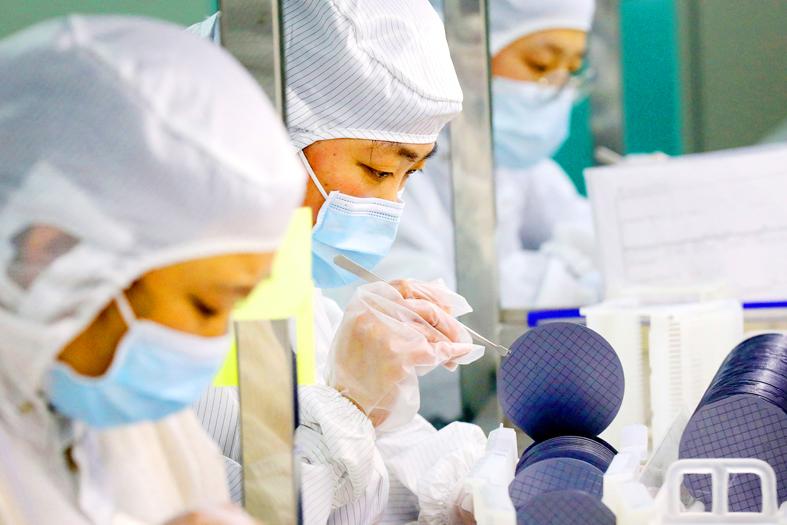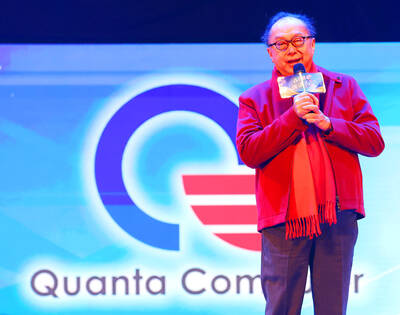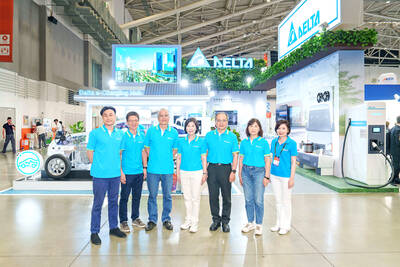Semiconductor Manufacturing International Corp (SMIC, 中芯國際) is to build a US$2.35 billion plant with funding from the Shenzhen City Government, the first major project to emerge from China’s master plan to match the US and become more self-reliant amid a global chip shortage.
SMIC yesterday said that shortages could worsen this year and next, harming Chinese businesses if the country does not immediately increase domestic capacity.
In the joint venture with Shenzhen, the company has agreed to develop and operate a manufacturing facility that can produce chips using 28-nanometer technology, it said in a stock exchange filing.

Photo: AFP
The partners aim to attract third-party investment, begin production by next year and eventually produce 40,000 12-inch wafers per month.
“The shortage in chip manufacturing capacity is very real, and the situation could deteriorate in 2021 and 2022 if Chinese companies don’t speed up expansion,” SMIC senior vice president Zhang Xin (張昕) told the SEMICON China conference in Shanghai.
Beijing is moving swiftly to cut a dependence on the West for crucial components such as chips, an issue that became more urgent after a global shortage of semiconductors worsened during the COVID-19 pandemic.
Washington has also blacklisted major Chinese tech firms, including SMIC, cutting it off from US technology, while severely impairing its ability to procure the equipment it needs to make chips.
It remains unclear whether US President Joe Biden’s administration might allow US firms to resume selling to SMIC on a large scale, or ease up on pressuring allies in Europe and elsewhere to boycott the Chinese company.
Mergers with the government might prove essential to achieving the country’s ambitions. Chinese chipmakers aim to progress past the more mature 28-nanometer nodes — now used in industries from automaking to TVs — but need billions of dollars and years of research to produce more sophisticated semiconductors for gadgets such as smartphones.
Much of China’s hopes rest on making headway in burgeoning fields such as artificial intelligence and third-generation chips: Mainly made of materials such as silicon carbide and gallium nitride, they can operate at high frequency and in higher power and temperature environments, with broad applications in 5G, military-grade radar and electric vehicles.
SMIC’s Shenzhen project would mark one of the few plants in the country focused on larger 12-inch rather than 8-inch wafers, which save on cost because more chips can be sliced from it, but are far more difficult to fabricate.
SMIC operates fabs in four cities, including Beijing and Shanghai. It would own 55 percent of the planned factory, with a government-owned entity owning up to a 23 percent stake.
“Silicon wafer is a fundamental raw material in semiconductor manufacturing, yet it is also one of the areas in China’s semiconductor supply chain that has the lowest level of local production, especially 12-inch silicon wafers,” Li Wei (李煒), executive vice president of the National Silicon Industry Group (矽產業集團), a state-backed wafer manufacturer, told the conference on Wednesday.

Quanta Computer Inc (廣達) chairman Barry Lam (林百里) is expected to share his views about the artificial intelligence (AI) industry’s prospects during his speech at the company’s 37th anniversary ceremony, as AI servers have become a new growth engine for the equipment manufacturing service provider. Lam’s speech is much anticipated, as Quanta has risen as one of the world’s major AI server suppliers. The company reported a 30 percent year-on-year growth in consolidated revenue to NT$1.41 trillion (US$43.35 billion) last year, thanks to fast-growing demand for servers, especially those with AI capabilities. The company told investors in November last year that

Intel Corp has named Tasha Chuang (莊蓓瑜) to lead Intel Taiwan in a bid to reinforce relations between the company and its Taiwanese partners. The appointment of Chuang as general manager for Intel Taiwan takes effect on Thursday, the firm said in a statement yesterday. Chuang is to lead her team in Taiwan to pursue product development and sales growth in an effort to reinforce the company’s ties with its partners and clients, Intel said. Chuang was previously in charge of managing Intel’s ties with leading Taiwanese PC brand Asustek Computer Inc (華碩), which included helping Asustek strengthen its global businesses, the company

Taiwanese suppliers to Taiwan Semiconductor Manufacturing Co. (TSMC, 台積電) are expected to follow the contract chipmaker’s step to invest in the US, but their relocation may be seven to eight years away, Minister of Economic Affairs J.W. Kuo (郭智輝) said yesterday. When asked by opposition Chinese Nationalist Party (KMT) Legislator Niu Hsu-ting (牛煦庭) in the legislature about growing concerns that TSMC’s huge investments in the US will prompt its suppliers to follow suit, Kuo said based on the chipmaker’s current limited production volume, it is unlikely to lead its supply chain to go there for now. “Unless TSMC completes its planned six

Power supply and electronic components maker Delta Electronics Inc (台達電) yesterday said it plans to ship its new 1 megawatt charging systems for electric trucks and buses in the first half of next year at the earliest. The new charging piles, which deliver up to 1 megawatt of charging power, are designed for heavy-duty electric vehicles, and support a maximum current of 1,500 amperes and output of 1,250 volts, Delta said in a news release. “If everything goes smoothly, we could begin shipping those new charging systems as early as in the first half of next year,” a company official said. The new